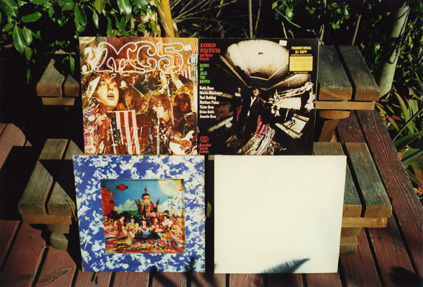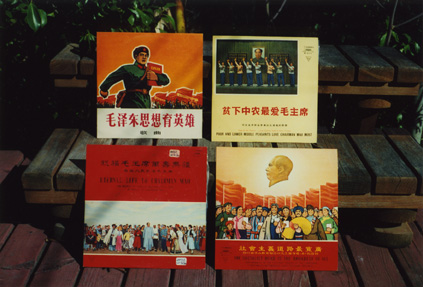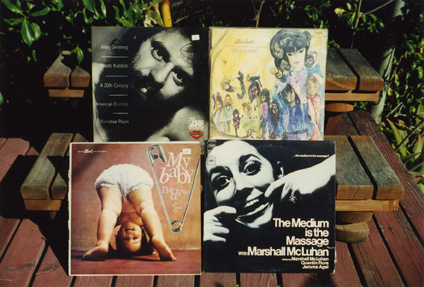 





I start with a close listen to the song. It's a slow instrumental in E minor, full of major sixths, a lush pop orchestration from the 1960s. The solo instrument sounds like koto or shamisen. The orchestra could be American or Japanese -- Japanese, if I had to lay money on it.. There are no lyrics to Google, and I don't recognize the melody. I make a list of everything I know about the source recording. The source tape is a home recording of the Firesign Theatre's Dear Friends, broadcast on KPFK-FM Los Angeles on November 22, 1970. The participants are the Firesign Theatre -- Philip Austin, Peter Bergman, David Ossman, and Philip Proctor -- and their engineer Live Earl Jive and producer Bill McIntyre. From interviewing all six of them, I know that all music cues in the Dear Friends series came from the members of Firesign or from Jive; nothing came from the KPFK library, which was inaccessible during their broadcasts. The full one-hour Dear Friends broadcast for 11/22/1970 contains at least 15 record cues with Japanese origins, including "Drif No Zundokobushi" and "Taihen Utaikomi" by The Drifters, two pop ballads by an unknown female vocalist, male and female Japanese language records, "Sukiyaki" by Kyu Sakamoto, three old records of 1940s vintage, and five pop instrumentals (of which this mystery track is one) which all share this song's instrumentation and style of arrangement. I play the song for Firesign and for Jiver; they can't identify it. Ossman checks his record collection and eventually says "If it was mine, I can't locate it." I dig through all of Proctor's records myself and come up empty.
 I encode all the cues to MP3 and post them to my web site. I send email queries to people I think could help, including Tom Schnabel, host of Café L.A., a world music show on KCRW Santa Monica; Glenn Sadin, a Group Sounds enthusiast in San Francisco; Izumi D, host of Tokyo Bugi-Ugi, a Japanese pop show on WBAR New York; Siran Babayan, an L.A. Weekly contributor who once wrote an article on shopping for J-Pop in Little Tokyo; Shigemi Komiyama, a Group Sounds fan and surf band drummer from the Bay area; and Tomi-San, a friend of a friend who works at a Micron plant in Tokyo. The only one who responds with a lead is Tomi-San, who says "It's a Japanese traditional lullaby at the west part of Japan island." He points me to a Japanese midi site. The melody is an exact match. The name of the song is given at the top of the page: 中国地方の子守唄 However "komori" is only part of the name of the song in English, and the best available robo-translation comes back with only "Baby Sitter of Chinese District 唄". I need the full title transliterated to English so I can say it ... and Google it in both English and Japanese. I don't know Japanese, so I begin at the beginning and start researching Kanji. Two useful sites are The Kanji Site and Kiki's Kanji Dictionary. Of the three major Japanese written language systems, Kanji is the ideogram system and Hiragana is the syllabic alphabet. A kanji symbol -- or a cluster of kanji called a compound -- constitutes a "word" (kind of) and that word can be spelled out syllabically in hiragana. Each hiragana symbol has a simple English syllable substitute, which is how you make English transliterations of Japanese words. I have to separate the eight Kanji into words, so I start with の, which is one of 46 basic unvoiced hiragana pronounced "no". 唄 contains two glyphs, or "radicals". The first radical is a mouth. I look it up in the radical index and see it's part of a kanji meaning "songs with samisen" with a hiragana spelling that transliterates to "uta".
 I look up 子 in the radical index and see it means "child". I look it up in the compound index and see it paired with another kanji with a crown radical on top that means "guard, protect, defend, obey"; the compound means "babysitter, nursemaid". The hiragana for this compound is "komori", which is the part of the song name I already know. I now have transliterations of kanji numbers 5-8, の子守唄: "No Komori Uta". I find kanji #4, 方, in the radical index; it means "direction". #3, 地, starts with a three-stroke radical meaning "earth", and on a list of "earth" radicals I find this kanji, which also means "earth" or "ground". #2, 国, is surrounded by the "box" radical, and on a list of "box" radicals I find this kanji which means "country". "Country" also forms part of a compound with kanji #1, 中, and together they mean "China/southwest-most region of Honshu/middle of a country/Hiroshima area". 中 by itself means "in/inside/middle/mean/center". Since Tomi says this is a lullaby from the "west part of Japan island" and 中国 means "southwest-most region of Honshu", I look up Honshu in Wikipedia and find a list of prefectures. I start with the westernmost prefecture, Chugoku, and find that the Kanji for "Chugoku Region" or "Chugoku-Chiho" matches my mystery kanji numbers 1, 2, 3, and 4. Now I have my complete song title transliterated into English: "Chugoku-Chiho No Komori Uta". A web page from the International Shakuhachi Society lists albums on which this song has appeared. Second on the list is Miyagi Mamoru's Japan Revisited, Capitol Records T10195. There's no year, but there's a scan of the cover, and it looks like the right vintage. I buy the record on eBay and listen to the cut. It doesn't match. In June 2005 I make a field trip to little Tokyo in Japantown. I visit the Kinokuniya, Asahiya, and Magic Cat stores -- not a lot of used vinyl. The Bun-ka Do has an amazing selection of import laserdiscs and CDs, but no records. I search "Chugoku" at All Music Guide; I get eight hits. They don't pan out for various reasons -- wrong instrumentation, wrong year of release. I try to contact Capitol "Ultra-Lounge" series producer Brad Benedict; no luck. I follow a lead that it might be Nisei music from post-war Hawaii. I run down a complete list of Tak Shindo LPs, but he never recorded this song. Ditto for Paul Mark (Kokeshi Shindig, etc.) An LP called Hi-Fi in an Oriental Garden looks promising. I buy a copy. The song doesn't match.
 I work through the list of other mystery instrumentals from the same show, hoping they all came from the same album. Hitting the same research sources, I work out song titles for three of them: "Toryanse" (通りゃんせ), "Tawara wa Gorogoro" (俵はごろごろ), and "Anta-gata-dokosa" (あんたがたどこさ). I identify "Tawara wa Gorogoro" only after listening to every Midi sample on a random Japanese page of more than 350 songs. Now I have a good lead: all of these songs are Japanese children's songs. I still can't find any LP names when I Google all four track names together. However I was able to find the HTML codes for all the kanji, so I could write and publicize a web page with information about all five songs, including sound samples. In May 2007 I email Florida DJ Q-Burns Abstract Message about it, he forwards my email to Xeni Jardin at tech blog BoingBoing, and she blogs about it . Finally in David Ossman's collection I find an open reel with production music that he used as instrumental backgrounds during the Let's Eat series in 1971-1972. There are two good one-minute clips from "Antagatadokosa" and "Toryanse". This means that at some point he had that LP sleeve in his hands in a production room at KPFK, the record spinning on the turntable as he dubbed parts of it to reel-to-reel. Quick, somebody take a picture... Sigh. Well, at least it's further evidence that this record actually physically existed. As of 2010, this record remains unidentified. I consider it the most fun aspect of a years-long obsession with identifying every record cue that Firesign played during the Radio Hour Hour, Dear Friends, and Let's Eat broadcasts ... and I've got pretty good returns, considering that there were 1007 needle-drops throughout all the shows and I've identified 787 of them. And I still hold out hope of finding it at some point. After all, imagine if you were Japanese, and all you had was a sweet, cooking recording of someone playing a boogie-woogie version of Rachmaninoff's Prelude in C-sharp minor -- it's a small jazz combo, maybe it's from the 1950s, maybe it's an American record, what else can you really tell about such a thing? What are the odds you could ever identify it, let alone find a copy? And yet, I have it.

|
